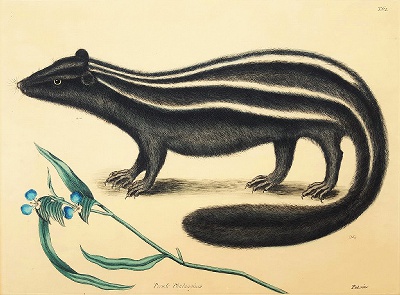
ANTIQUE PRINTS
Mark CATESBY (English, 1683-1749)
Mark CATESBY (English, 1683-1749)
Title: "The Loggerhead Turtle" (Plate/Tab 40)
*Very rare
Portfolio: Natural History of Carolina, Florida & the Bahama Islands
Year: 1754 (second edition)
Medium: Original Hand-Colored Etching
Limited edition: Unknown
Matted size: 17.25" x 21.5"
Sheet size: 14" x 20.75"
Image size: 10.25" x 14"
Price: SOLD
*Very rare
Portfolio: Natural History of Carolina, Florida & the Bahama Islands
Year: 1754 (second edition)
Medium: Original Hand-Colored Etching
Limited edition: Unknown
Matted size: 17.25" x 21.5"
Sheet size: 14" x 20.75"
Image size: 10.25" x 14"
Price: SOLD
Mark Catesby (24 March 1683 – 23 December 1749) was an English naturalist. Between 1729 and 1747 Catesby published his Natural History of Carolina, Florida and
the Bahama Islands, the first published account of the flora and fauna of North America. It included 220 plates of birds, reptiles, amphibians, fish, insects, mammals
and plants. Mark Catesby's The Natural History of Carolina, Florida and the Bahama Islands is generally credited as the first published work to provide illustrations
and descriptions of North American flora and fauna. From 1722-1726 Catesby, an English naturalist, ranged over South Carolina, Georgia and the Bahamas sketching
and collecting specimens of native plants and animals. Little is known of Catesby's early life. He was born in eastern England in 1683. Although Catesby does not
appear to have attended university or studied for the Bar, he was sufficiently educated to write clear English and Latin. His interest in and knowledge of plants may
have derived from his uncle, who maintained a botanical garden. Catesby also appears to have benefited from an acquaintance with John Ray, a leading English
naturalist of the 17th century and the co-author of an early classic study of birds. It is unclear when or how Catesby developed his skills as an artist.
Catesby's first visit to North America occurred in 1712 when he traveled to Williamsburg, Virginia, to live with his sister and her husband, who had settled there. During his seven-year stay, he explored the length of the James River sketching plants and collecting botanical samples. Upon Catesby's return to England in 1719, his work in Virginia drew the attention of several influential members of the Royal Society. And with their financial backing, Catesby returned to North America three years later, arriving in Charleston in May 1722. During his four-year stay, he traveled throughout South Carolina, coastal Georgia and to the Bahamas. The sketches and specimens Catesby gathered during his second North American trip formed the basis for The Natural History of Carolina, Florida and the Bahama Islands. Although most often found as a two-volume set, Catesby's Natural History was published in 11 discrete sections from 1734-1747 and sold by subscription. Although Catesby died in 1749, his work was republished in 1754 and again in 1771. Catesby's work predated the classification system developed by Swedish botanist Carl Linneaus. However, the 1771 edition, featured here, includes a catalog of the Linnean names for the plants and animals Catesby featured in Natural History.
Catesby's first visit to North America occurred in 1712 when he traveled to Williamsburg, Virginia, to live with his sister and her husband, who had settled there. During his seven-year stay, he explored the length of the James River sketching plants and collecting botanical samples. Upon Catesby's return to England in 1719, his work in Virginia drew the attention of several influential members of the Royal Society. And with their financial backing, Catesby returned to North America three years later, arriving in Charleston in May 1722. During his four-year stay, he traveled throughout South Carolina, coastal Georgia and to the Bahamas. The sketches and specimens Catesby gathered during his second North American trip formed the basis for The Natural History of Carolina, Florida and the Bahama Islands. Although most often found as a two-volume set, Catesby's Natural History was published in 11 discrete sections from 1734-1747 and sold by subscription. Although Catesby died in 1749, his work was republished in 1754 and again in 1771. Catesby's work predated the classification system developed by Swedish botanist Carl Linneaus. However, the 1771 edition, featured here, includes a catalog of the Linnean names for the plants and animals Catesby featured in Natural History.
Title: "The Pole-Cat (Skunk)" (Plate/Tab 62)
*Very rare
Portfolio: Natural History of Carolina, Florida & the Bahama Islands
Year: 1771-1810 (third edition)
Medium: Original Hand-Colored Etching
Limited edition: Unknown
Framed size: 21.63" x 25.19"
Sheet size: 13.75" x 21.13"
Platemark size: 10.25" x 13.75"
Price: $650
*Very rare
Portfolio: Natural History of Carolina, Florida & the Bahama Islands
Year: 1771-1810 (third edition)
Medium: Original Hand-Colored Etching
Limited edition: Unknown
Framed size: 21.63" x 25.19"
Sheet size: 13.75" x 21.13"
Platemark size: 10.25" x 13.75"
Price: $650
FINE ART INVESTMENTS SINCE 1978
3430 Red Cloud Trail, Saint Augustine, FL 32086
904-547-2591
gravesfineart1@gmail.com
904-547-2591
gravesfineart1@gmail.com


